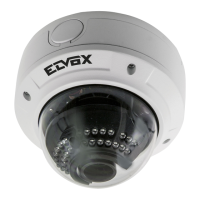Viale Vicenza, 14
36063 Marostica VI - Italy
www.vimar.com
46226.312D.01
49401025A0 02 1701
Collegamento dell'allarme
- Ingresso allarme: Sono presenti un morsetto indipendente
di ingresso allarme (ALM-IN) e un morsetto di messa a terra
(ALM‑GND). Non sono richiesti sensori di tipo specico, dato che
sarà possibile selezionare la modalità NO (normalmente aperto) o NC
(normalmente chiuso). Unire i terminali di messa a terra del sensore e
della telecamera, quindi collegare il cavo del segnale del sensore alla
porta di ingresso allarme della telecamera.
- Uscita allarme: È presente un’uscita allarme 1 CH, disponibile sulle
connessioni COM e NO.
Allentare le viti del morsetto di uscita allarme. Collegare i cavi del
dispositivo di allarme rispettivamente alle connessioni NO e COM.
Inne serrare le viti. Alcuni dispositivi esterni di uscita allarme
necessitano di alimentazione.
Connessione RS485
È possibile controllare la Speed dome tramite l'interfaccia RS485.
Connessione cavo di rete
1
2
3
4. Installazione
Prima di iniziare, assicurarsi che la parete o il softto siano
sufcientemente solidi per sopportare tre volte il peso della telecamera.
Installare e utilizzare la telecamera in ambiente asciutto. Si consiglia
di riposizionare la cupola inferiore entro 4 ore dalla sua rimozione. La
procedura di montaggio è la seguente:
1) Allentare le viti per aprire la cupola inferiore, quindi allentare la vite di
bloccaggio per rimuovere la base di montaggio.
Vite di bloccaggio
Lock Screw
2) Posizionare la dima per la foratura dove si intende ssare la
telecamera, quindi praticare i 4 fori per le viti e il foro per i cavi (nel
caso si intenda far passare i cavi attraverso la base di montaggio) in
base alla dima.
4) Fissare la telecamera alla base di montaggio con la vite di bloccaggio
.
3) Passare i cavi e collegarli. Quindi ssare la base di montaggio al
softto o parete con le viti.
Softto o parete
Ceiling or Wall
Alarm Connection
- Alarm Input: There is one independent alarm input port (ALM-IN)
and one grounding port (ALM-GND).There are no type requirements
for sensors. NO and NC are both available. Join the grounding ends
of the sensor and the camera and then connect the signal cable of the
sensor to the alarm input port of the camera.
- Alarm Output: There is 1 CH alarm output including COM and NO
connections.
Loosen the screws in the alarm output port. Then insert the signal
wires of the alarm output devices into the port of NO and COM sepa-
rately. Finally tighten the screws. Some of the external alarm output
devices need the power supply.
RS 485 Connection
You can control the speed dome by RS485 interfaces.
Network Cable Connection
4. Installation
Before start, please make sure that the wall or ceiling is strong enough
to withstand 3 times the weight of the camera. Please install and use the
camera in the dry environment. You’d better install back the lower dome
less than 4 hours after removing it. The mounting steps are as follows:
1) Loosen the screws to open the lower dome and then loosen the lock
screw to remove the mounting base.
2) Attach the drill template to the place where you want to x the camera
and then drill 4 screw holes and 1 cable hole (if you want to route the
cables through the mounting base) according to the drill template.
4) Fix the camera to the mounting base with the lock screw.
3) Route the cables and connect these cables. And then secure the
mounting base to the ceiling or wall with screws.
Softto o parete
Ceiling or Wall

